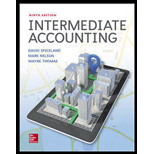
INTERMEDIATE ACCOUNTING (LL) W/CONNECT
9th Edition
ISBN: 9781260679694
Author: SPICELAND
Publisher: MCG
expand_more
expand_more
format_list_bulleted
Question
Chapter 3, Problem 3.8Q
To determine
Property, plant, equipment:
PP&E are the tangible assets which are pivotal for the business operations and can be used for more than a year.
Intangible assets:
Intangible assets are characterized by not having physical existence, for example patents, trade mark, copyrights.
To determine:
Difference between property, plant, equipment and intangible assets.
Expert Solution & Answer
Want to see the full answer?
Check out a sample textbook solution
Students have asked these similar questions
The ending inventory of Thornton Supplies Inc. is $45,000. If the beginning inventory was $62,000 and goods available for sale totaled $148,000, what is the cost of goods sold?
Financial Accounting Question
Hii teacher please provide for General accounting question answer do fast
Chapter 3 Solutions
INTERMEDIATE ACCOUNTING (LL) W/CONNECT
Ch. 3 - Prob. 3.1QCh. 3 - Prob. 3.2QCh. 3 - Define current assets and list the typical asset...Ch. 3 - Prob. 3.4QCh. 3 - Prob. 3.5QCh. 3 - Prob. 3.6QCh. 3 - Describe the common characteristics of assets...Ch. 3 - Prob. 3.8QCh. 3 - Prob. 3.9QCh. 3 - Define the terms paid-in-capital and retained...
Ch. 3 - Disclosure notes are an integral part of the...Ch. 3 - A summary of the companys significant accounting...Ch. 3 - Define a subsequent event.Ch. 3 - Prob. 3.14QCh. 3 - Prob. 3.15QCh. 3 - Prob. 3.16QCh. 3 - Prob. 3.17QCh. 3 - Show the calculation of the following solvency...Ch. 3 - Prob. 3.19QCh. 3 - Prob. 3.20QCh. 3 - (Based on Appendix 3) Segment reporting...Ch. 3 - Prob. 3.22QCh. 3 - Prob. 3.23QCh. 3 - Current versus long-term classification LO32,...Ch. 3 - Balance sheet classification LO32, LO33 The trial...Ch. 3 - Prob. 3.3BECh. 3 - Balance sheet classification LO32, LO33 Refer to...Ch. 3 - Balance sheet classification LO32, LO33 The...Ch. 3 - Balance sheet classification LO32, LO33 You have...Ch. 3 - Balance sheet preparation; missing elements LO32,...Ch. 3 - Financial statement disclosures LO34 For each of...Ch. 3 - Calculating ratios LO38 Refer to the trial...Ch. 3 - Prob. 3.10BECh. 3 - Calculating ratios; solving for unknowns LO38 The...Ch. 3 - Balance sheet; missing elements LO32, LO33, LO38...Ch. 3 - Balance sheet classification LO32, LO33 The...Ch. 3 - Balance sheet classification LO32, LO33 The...Ch. 3 - Balance sheet preparation LO32, LO33 The...Ch. 3 - Balance sheet preparation LO32, LO33 The...Ch. 3 - Balance sheet; Current versus long-term...Ch. 3 - Prob. 3.7ECh. 3 - Prob. 3.8ECh. 3 - Balance sheet preparation LO32, LO33 The...Ch. 3 - Financial statement disclosures LO34 The...Ch. 3 - Prob. 3.11ECh. 3 - Prob. 3.12ECh. 3 - Prob. 3.13ECh. 3 - FASB codification research LO32, LO34 Access the...Ch. 3 - Prob. 3.15ECh. 3 - Prob. 3.16ECh. 3 - Prob. 3.17ECh. 3 - Calculating ratios; solve for unknowns LO38 The...Ch. 3 - Prob. 3.19ECh. 3 - Effect of management decisions on ratios LO38...Ch. 3 - Prob. 3.21ECh. 3 - Prob. 3.22ECh. 3 - Balance sheet preparation LO32, LO33 Presented...Ch. 3 - Balance sheet preparation; missing elements LO32,...Ch. 3 - Balance sheet preparation LO32, LO33 The...Ch. 3 - Balance sheet preparation LO32, LO33 The...Ch. 3 - Balance sheet preparation LO32, LO33 The...Ch. 3 - Prob. 3.6PCh. 3 - Balance sheet preparation; errors LO32, LO33 The...Ch. 3 - Balance sheet; errors; missing amounts LO32, LO33...Ch. 3 - Balance sheet preparation LO32 , LO33 Presented...Ch. 3 - Prob. 3.10PCh. 3 - Communication Case 31 Current versus long-term...Ch. 3 - Analysis Case 32 Current versus long- term...Ch. 3 - Prob. 3.4BYPCh. 3 - Judgment Case 35 Balance sheet; errors LO32...Ch. 3 - Prob. 3.6BYPCh. 3 - Real World Case 37 Balance sheet and significant...Ch. 3 - Judgment Case 38 Post fiscal year-end e vents ...Ch. 3 - Prob. 3.9BYPCh. 3 - Prob. 3.10BYPCh. 3 - Prob. 3.11BYPCh. 3 - Analysis Case 314 Balance sheet information LO32...Ch. 3 - Prob. 3.15BYPCh. 3 - Ethics Case 316 Segment reporting Appendix 3 You...Ch. 3 - Prob. 1CCTC
Knowledge Booster
Similar questions
- I need assistance with this general accounting question using appropriate principles.arrow_forwardCompute the amount of underapplid or overaplied overhead cost for the yeararrow_forwardRegency Distributors wants an ending inventory each month equal to 20% of that month's cost of sales. Cost of sales for April is projected at $150,000. Ending inventory at the end of March was $25,000. Based on this information, purchases for April will be: a. $125,000 b. $130,000 c. $145,000 d. $155,000arrow_forward
arrow_back_ios
SEE MORE QUESTIONS
arrow_forward_ios
Recommended textbooks for you
- Principles of Accounting Volume 1AccountingISBN:9781947172685Author:OpenStaxPublisher:OpenStax College
 Cornerstones of Financial AccountingAccountingISBN:9781337690881Author:Jay Rich, Jeff JonesPublisher:Cengage Learning
Cornerstones of Financial AccountingAccountingISBN:9781337690881Author:Jay Rich, Jeff JonesPublisher:Cengage Learning

Principles of Accounting Volume 1
Accounting
ISBN:9781947172685
Author:OpenStax
Publisher:OpenStax College

Cornerstones of Financial Accounting
Accounting
ISBN:9781337690881
Author:Jay Rich, Jeff Jones
Publisher:Cengage Learning
